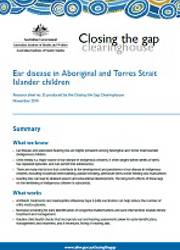Ear disease in Aboriginal and Torres Strait Islander children
Citation
AIHW
The Closing the Gap Clearinghouse (2014) Ear disease in Aboriginal and Torres Strait Islander children, AIHW, Australian Government, accessed 26 April 2024.
APA
The Closing the Gap Clearinghouse. (2014). Ear disease in Aboriginal and Torres Strait Islander children. Canberra: AIHW.
MLA
The Closing the Gap Clearinghouse. Ear disease in Aboriginal and Torres Strait Islander children. AIHW, 2014.
Vancouver
The Closing the Gap Clearinghouse. Ear disease in Aboriginal and Torres Strait Islander children. Canberra: AIHW; 2014.
Harvard
The Closing the Gap Clearinghouse 2014, Ear disease in Aboriginal and Torres Strait Islander children, AIHW, Canberra.
PDF | 241Kb
Ear disease and associated hearing loss are significant health problems for Indigenous children, and also contribute to poor educational achievement, higher unemployment, and, as a consequence, greater contact with the criminal justice system later in life. Thus, preventing ear disease in Indigenous children is a high priority. This resource sheet reviews past and current programs, research and strategies for the prevention and treatment of ear disease in Indigenous children. It examines what works, what doesn't, and what further research is needed. Risk factors, incidence, and prevalence are also noted.
Part of Closing the Gap Clearinghouse.
- ISSN: 2201-845X
- ISBN: 978-1-74249-557-6
- Cat. no: IHW 122
- Pages: 25
-
Ear disease and associated hearing loss are highly prevalent among Indigenous children
-
Hearing loss can lead to delayed speech and educational development
-
The long-term effects of delayed speech and educational development on the child’s wellbeing is substantial



